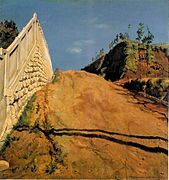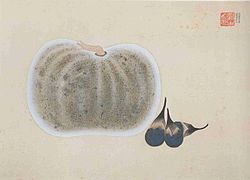Kishida Ryusei
Kishida Ryūsei ( Japanese 岸 田 劉 生 ; born June 23, 1891 ; died December 20, 1929 ) was a Japanese painter.
Life
Kishida was born in Tōkyō as the son of the journalist Kishida Ginkō. His father, who u. a. edited the first Japanese-English dictionary with James Curtis Hepburn , provided the son with a stimulating environment. However, Kishida lost both parents at the age of 14, which made living conditions difficult. He came into contact with the Christian Church and was baptized when he was 15. At 17 he attended the private art school directed by Kuroda Seiki , which taught a degree in Western art.
In 1910 Kishida was able to show first works in the annual Hakubai exhibition. In 1911 he met Mushanokōji Saneatsu , at that time the great stimulator and mediator of European art in Japan. Kishida described the meeting as her second birthday . He made a few front pages for Mushanokōji's magazine Shirakaba ( The Birch ), which then devoted an entire issue to him. With Takemura Kōtarō, Bernard Leach u. a. In 1911 he founded Fyūzan-kai . With his own small publishing house, Sōdō-sha, he tried to make a living. In 1922, encouraged by Umehara Ryūzaburō , he joined the Shun'yō-kai artists' association , but two years later, due to differences of opinion, left again. In 1926 he moved away from Tōkyō and settled near Kamakura (Kanagawa Prefecture). In 1929 he was in Manchuria.
Kishida died after a brief illness at the end of 1929 at the age of 38.
Aftermath
Kishida painted his pictures in a rapidly changing time. We find Late Impressionism, Fauvism , but also recourse to Chardin or German Renaissance painting. In his last years, Kishida became interested in painted ukiyo-e and nihonga .
The painting Der Durchstich has its firm place in the Japanese art history of the time: A shadow falls on the piercing cut into nature on the edge of Tōkyō, not the shadow of a tree, but that of a power pole with its support. Modern times with their double-edgedness are made visible. - The many pictures of his daughter Reiko, born in 1914, are also very well known. The best-known oil painting of her is in the Renaissance style, with Reiko's hand position unmistakably pointing to Dürer's self-portrait as a young man. Kishida's self-portraits are more reminiscent of Holbein. In the later years he also began to be interested in painted ukiyo-e and classical Japanese ink painting .
photos
" Mushanokōji " (1914)
Remarks
- ^ Fusain Society , fusain = charcoal / charcoal drawing.
- ↑ This picture was shown at the exhibition Japanese Painting in Western Style 1985 in the Museum for East Asian Art in Cologne.
literature
- Catalog for the exhibition Kishida Ryūsei - Reiko . Fukuyama Museum of Art, 2003
- Catalog for the exhibition Kishida Ryūsei . Aichi Prefectural Museum of Art, Museum of Modern Art Kamakura, Kasama Nichido Museum of Art, 2001
- Japan Foundation (Ed.): Japanese Painting in the Western Style, 19th and 20th Centuries. Exhibition catalog, Cologne, 1985.
Web links
| personal data | |
|---|---|
| SURNAME | Kishida, Ryūsei |
| ALTERNATIVE NAMES | 岸 田 劉 生 (Japanese) |
| BRIEF DESCRIPTION | Japanese painter |
| DATE OF BIRTH | June 23, 1891 |
| DATE OF DEATH | December 20, 1929 |






